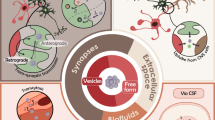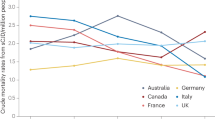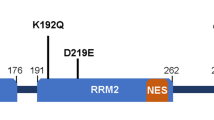Abstract
Mammalian transmissible spongiform encephalopathy (prion) and amyloid diseases seem to involve the self-propagation of abnormal fibrillar or sub-fibrillar protein aggregates. Similar processes explain protein-mediated inheritance by yeast prions. Indeed, yeast prions are more surely mediated solely by aberrant protein aggregates than are their mammalian namesakes. Tantalizing parallels make yeast prions attractive models of mammalian protein-folding diseases.
This is a preview of subscription content, access via your institution
Access options
Subscribe to this journal
Receive 12 print issues and online access
$209.00 per year
only $17.42 per issue
Buy this article
- Purchase on Springer Link
- Instant access to full article PDF
Prices may be subject to local taxes which are calculated during checkout



Similar content being viewed by others
References
Griffith, J.S. Self-replication and scrapie. Nature 215, 1043–1044 (1967).
Prusiner, S.B. Prions. Proc. Natl. Acad. Sci. USA 95, 13363 –13383 (1998).
Horiuchi, M. & Caughey, B. Prion protein interconversions and the transmissible spongiform encephalopathies. Structure Fold. Des. 7, R231–240 ( 1999).
Wickner, R.B. [URE3] as an altered URE2 protein: evidence for a prion analog in Saccharomyces cerevisiae. Science 264, 566– 569 (1994).
Sondheimer, N. & Lindquist, S. Rnq1: an epigenetic modifier of protein function in yeast. Mol. Cell 5, 163–172 (2000).
Li, L. & Lindquist, S. Creating a protein-based element of inheritance. Science 287, 661– 664 (2000).
Santoso, A., Chien, P., Osherovich, L.Z. & Weissman, J.S. Molecular basis of a yeast prion species barrier. Cell 100, 277–288 (2000).
Kocisko, D.A. et al. Cell-free formation of protease-resistant prion protein. Nature 370, 471–474 ( 1994).
Lasmezas, C.I. et al. Transmission of the BSE agent to mice in the absence of detectable abnormal prion protein. Science 275, 402 –405 (1997).
Akowitz, A., Sklaviadis, T., Manuelidis, E.E. & Manuelidis, L. Nuclease-resistant polyadenylated RNAs of significant size are detected by PCR in highly purified Creutzfeldt-Jakob disease preparations. Microb. Pathog. 9, 33–45 (1990).
Appel, T.R., Dumpitak, C., Matthiesen, U. & Riesner, D. Prion rods contain an inert polysaccharide scaffold. Biol. Chem. 380, 1295–1306 ( 1999).
Klein, T.R., Kirsch, D., Kaufmann, R. & Riesner, D. Prion rods contain small amounts of two host sphingolipids as revealed by thin-layer chromatography and mass spectrometry. Biol. Chem. 379, 655–666 (1998).
Wickner, R.B., Edskes, H.K., Maddelein, M.L., Taylor, K.L. & Moriyama, H. Prions of yeast and fungi. Proteins as genetic material. J. Biol. Chem. 274, 555–558 (1999).
Maddelein, M.L. & Wickner, R.B. Two prion-inducing regions of Ure2p are nonoverlapping. Mol. Cell Biol. 19, 4516–4524 (1999).
Masison, D.C. & Wickner, R.B. Prion-inducing domain of yeast Ure2p and protease resistance of Ure2p in prion-containing cells . Science 270, 93–95 (1995).
Taylor, K.L., Cheng, N., Williams, R.W., Steven, A.C. & Wickner, R.B. Prion domain initiation of amyloid formation in vitro from native Ure2p. Science 283, 1339–1343 (1999).
Patino, M.M., Liu, J.J., Glover, J.R. & Lindquist, S. Support for the prion hypothesis for inheritance of a phenotypic trait in yeast. Science 273, 622–626 ( 1996).
Glover, J.R. et al. Self-seeded fibers formed by sup35, the protein determinant of [PSI+], a heritable prion-like factor of S. cerevisiae . Cell 89, 811–819 (1997).
King, C.Y. et al. Prion-inducing domain 2–114 of yeast Sup35 protein transforms in vitro into amyloid-like filaments. Proc. Natl. Acad. Sci. USA 94, 6618–6622 ( 1997).
Paushkin, S.V., Kushnirov, V.V., Smirnov, V.N. & Ter-Avanesyan, M.D. In vitro propagation of the prion-like state of yeast Sup35 protein. Science 277, 381 –383 (1997).
Paushkin, S.V., Kushnirov, V.V., Smirnov, V.N. & Ter-Avanesyan, M.D. Propagation of the yeast prion-like [psi+] determinant is mediated by oligomerization of the SUP35-encoded polypeptide chain release factor. EMBO J. 15, 3127– 3134 (1996).
Prusiner, S.B. et al. Scrapie prions aggregate to form amyloid-like birefringent rods. Cell 35, 349–358 (1983).
Kisilevsky, R., Lemieux, L., Boudreau, L., Yang, D.S. & Fraser, P. New clothes for amyloid enhancing factor (AEF): silk as AEF. Amyloid 6, 98 –106 (1999).
Johan, K. et al. Acceleration of amyloid protein A amyloidosis by amyloid-like synthetic fibrils. Proc. Natl. Acad. Sci. USA 95, 2558–2563 (1998).
Brown, P., Goldfarb, L.G. & Gajdusek, D.C. The new biology of spongiform encephalopathy: infectious amyloidoses with a genetic twist. Lancet 337, 1019–1022 (1991).
Jarrett, J.T. & Lansbury, P.T. Jr. Seeding “one-dimensional crystallization” of amyloid: A pathogenic mechanism in Alzheimer's disease and scrapie? Cell 73, 1055–1058 (1993).
Caughey, B., Kocisko, D.A., Raymond, G.J. & Lansbury, P.T. Aggregates of scrapie associated prion protein induce the cell-free conversion of protease-sensitive prion protein to the protease-resistant state. Chem. Biol. 2, 807–817 ( 1995).
Dobson, C.M. Protein misfolding, evolution and disease. Trends Biochem. Sci. 24, 329–332 ( 1999).
Riek, R., Hornemann, S., Wider, G., Glockshuber, R. & Wuthrich, K. NMR characterization of the full-length recombinant murine prion protein, mPrP(23-21). FEBS Lett. 413, 282–288 (1997).
Donne, D.G. et al. Structure of the recombinant full-length hamster prion protein PrP(29-231): the N terminus is highly flexible. Proc. Natl. Acad. Sci. USA 94, 13452–13457 (1997).
Thual, C. et al. Structural characterization of Saccharomyces cerevisiae prion-like protein Ure2. J. Biol. Chem. 274, 13666–13674 (1999).
Tuite, M.F. Yeast prions and their prion-forming domain. Cell 100 , 289–292 (2000).
Liu, J.J. & Lindquist, S. Oligopeptide-repeat expansions modulate ‘protein-only’ inheritance in yeast. Nature 400, 573–576 ( 1999).
Collinge, J. et al. Inherited prion disease with 144 base pair gene insertion. 2. Clinical and pathological features. Brain 115, 687–710 (1992).
Kaytor, M.D. & Warren, S.T. Aberrant protein deposition and neurological disease. J. Biol. Chem. 274, 37507–37510 (1999).
Fischer, M. et al. Prion protein (PrP) with amino-proximal deletions restoring susceptibility of PrP knockout mice to scrapie. EMBO J. 15, 1255–1264 (1996).
Priola, S.A. Prion protein and species barriers in the transmissible spongiform encephalopathies . Biomed. Pharmacother. 53, 27– 33 (1999).
Kocisko, D.A. et al. Species specificity in the cell-free conversion of prion protein to protease-resistant forms: a model for the scrapie species barrier. Proc. Natl. Acad. Sci. USA 92, 3923– 3927 (1995).
Raymond, G.J. et al. Molecular assessment of the transmissibilities of BSE and scrapie to humans. Nature 388, 285– 288 (1997).
Bossers, A. et al. Scrapie susceptibility-linked polymorphisms modulate the in vitro conversion of sheep prion protein to protease-resistant forms . Proc. Natl. Acad. Sci. USA 94, 4931– 4936 (1997).
Chernoff, Y.O. et al. Evolutionary conservation of prion-forming abilities of the yeast sup35 protein. Mol. Microbiol. 35, 865–876 (2000).
Kushnirov, V.V., Kochneva-Pervukhova, N.V., Chechenova, M.B., Frolova, N.S. & Ter-Avanesyan, M.D. Prion properties of the sup35 protein of yeast pichia methanolica. EMBO J. 19, 324–331 ( 2000).
Bessen, R.A. et al. Nongenetic propagation of strain-specific phenotypes of scrapie prion protein. Nature 375, 698– 700 (1995).
Derkatch, I.L., Chernoff, Y.O., Kushnirov, V.V., Inge-Vechtomov, S.G. & Liebman, S.W. Genesis and variability of [PSI] prion factors in Saccharomyces cerevisiae . Genetics 144, 1375– 1386 (1996).
Coustou, V., Deleu, C., Saupe, S. & Begueret, J. The protein product of the het-s heterokaryon incompatibility gene of the fungus Podospora anserina behaves as a prion analog. Proc. Natl. Acad. Sci. USA 94, 9773–9778 ( 1997).
Masison, D.C., Maddelein, M.L. & Wickner, R.B. The prion model for [URE3] of yeast: spontaneous generation and requirements for propagation. Proc. Natl. Acad. Sci. USA 94, 12503– 12508 (1997).
Caughey, B.W. et al. Secondary structure analysis of the scrapie-associated protein PrP 27–30 in water by infrared spectroscopy. Biochemistry 30, 7672–7680 ( 1991).
Acknowledgements
I thank W. Caughey, K. Hasenkrug and S. Priola for critically reading this manuscript and S.F. Hayes for assistance in obtaining the electron graph of PrP-res in Fig. 1.
Author information
Authors and Affiliations
Rights and permissions
About this article
Cite this article
Caughey, B. Transmissible spongiform encephalopathies, amyloidoses and yeast prions: Common threads?. Nat Med 6, 751–754 (2000). https://doi.org/10.1038/77476
Issue Date:
DOI: https://doi.org/10.1038/77476
This article is cited by
-
Alpha-Synuclein Transmission and Mitochondrial Toxicity in Primary Human Foetal Enteric Neurons In Vitro
Neurotoxicity Research (2014)
-
Comparative syntheses of peptides and peptide thioesters derived from mouse and human prion proteins
Amino Acids (2012)
-
Origins and Effects of Extracellular α-synuclein: Implications in Parkinson’s Disease
Journal of Molecular Neuroscience (2008)
-
Prying into prions
Nature (2005)
-
Structural insights into a yeast prion illuminate nucleation and strain diversity
Nature (2005)



